(HMS) Coronation
The 2nd Rate 90 gun warship Coronation was built for the Royal Navy in Portsmouth Dockyard by Master Shipwright Isaac Betts, she was one of nine 2nd rates of 90 guns included in the “thirty ships programme” initiated by Samuel Pepys, the industrious Secretary of the Admiralty, with the dedicated interest and support of Charles II in 1677. The programme was sanctioned by Act of Parliament and an amount in excess of £600,000 was voted for the building one new 1st Rate of 1,400 tons, nine 2nd Rates of 1,100 tons and twenty 3rd Rates of 900 tons, which were to be completed within two years - a prodigious task. The keel of the Coronation was laid down in 1680, but she was not launched until May 1685, named to commemorate the coronation of King James II, the only capital ship launched during his brief three year reign. The Coronation was the last ship of the programme to be completed as building work had been held up by lack of money and building materials, much of which came from the New Forest in Hampshire.
The gun-deck on the Coronation was 160ft 4in long with a beam of 44ft 9in, her displacement was 1346 tons (touch) and she had a complement of 660 in time of war. The original establishment of guns for a 2nd Rate was 90, but in 1691 with a war in progress the number of guns on board were increased to 94. Her fearsome armament was mounted on three decks, including 22 x 9ft 6in demi-cannon (32 pdr), 30 x 9ft culverin (18 pdr), 28 x 8ft 6in sakers (5.25 pdr), 12 x 7ft sakers (5.25 pdr) and 2 x 6ft 3 pdr guns.
Commissioned in 1689, a year later the Coronation took part in the Battle of Beachy Head as flagship of Sir Ralph Delavall, Vice Admiral of the blue squadron, which was heavily engaged with the French in the rear. By 1691 she was under the command of Captain Charles Skelton, serving in the Channel Fleet patrolling the French coast under Admiral Russell. Towards the end of the August bad weather forced the fleet to shelter and re-provision in the large anchorage of Torbay in south Devon. The situation improved and on 28th August the fleet, comprising 70 English and Dutch ships of the line supported by an armada of fireships and smaller vessels, weighed anchor and set out on another cruise into the Atlantic seeking the French fleet. On 2nd September while in the vicinity of Ushant, off Brittany, an increasing south westerly gale accompanied by an Atlantic swell caused Admiral Edward Russell to give the signal for the English fleet to steer easterly with the intention of returning to the safety of Torbay.
On the morning of September 3rd 1691 the wind increased to a full gale blowing from the south-south east; in bad visibility, finding himself dangerously near the treacherous Eddystone rocks, the Admiral gave the order for the allied Fleet to bear up for the limited shelter of Plymouth Sound. Unfortunately some of the great ships were too far to leeward to get round Penlee Point on the western side of the Sound and were forced to anchor offshore. Amongst these ships was the Coronation who attempted to anchor using her best bower, one of the large anchors she carried. As she was veering out the anchor cable a leak below decks increased alarmingly causing the ship to list heavily to port. In a desperate attempt to save the ship the Captain ordered her masts be cut away in the hope that this would reduce windage and bring the ship more upright. But this was to no avail; eyewitnesses on board other ships of the fleet saw the Coronation suddenly founder in 22 fathoms of water, taking most of her crew of 660 and Captain Skelton with her. The exact reasons for the loss of this great ship are unclear. Accounts vary, but as many as 25 seamen from the Coronation may have survived by good fortune, some clinging to wreckage, others in the ship’s long boat.
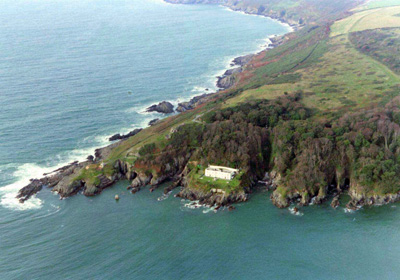
Penlee Point from the East
Many ships of the fleet managed to claw their way around Penlee Point, only to find Plymouth Sound offered little sanctuary due the south easterly direction of the storm blowing directly into the Sound. Of those ships anchoring in the Sound some sustained collision damage and others were driven from their anchors in great danger. Fourteen captains decided the risks were too great to anchor so they attempted to reach the safety of the Hamoaze by navigating the narrow channel in the Tamar river between Cremyll and Devil’s Point. A few ships made it to safety but with the tide ebbing strongly against them, twelve 70 gun 3rd rates, a 4th rate and two hospital ships were unlucky. One by one, the tide catching them under the starboard bow, they were driven ashore and into each other under Mount Edgcumbe House in a catastrophic melee of broken spars, rigging, ship’s heads and stern galleries. The main casualty was the Harwich, a 3rd rate, which bilged on a rock causing a great leak inside the ship. With 6ft of water in her hold and the leak increasing the crew were struggling desperately to pump her out when another 3rd rate, the Elizabeth, still under sail drove into the Harwich amidships ensuring her total loss. At 5pm the Harwich fell on her side and sank in the Barn Pool. Despite the dangers encountered only one life was lost in the dramatic series of events.
By late afternoon, and after much hard work, most of the other ships managed to extricate themselves and get off, except for the Northumberland and the Royal Oak, the latter initially throwing many of her guns overboard to lighten the ship. Over the next few days with the assistance of other ships by staving the beer and water barrels, unloading provisions, guns, shot and some ballast, both ships were lightened, re-floated, repaired and returned to service. It was later estimated that the storm had caused the Navy £200,000 worth of damage - an enormous sum at that time. Salvage work continued on the remains of the Harwich for the next three years as she was broken up and removed, but there should still be a number of artefacts from the ship in the area.
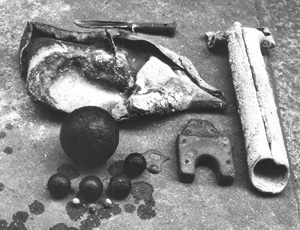
Finds recovered from the Inshore site
The remains of the Coronation lay on the seabed for nearly 300 years, until 1967 when Plymouth divers Terry Harrison, Alan Down and George Sandford found a few iron guns on the seabed close to Lady Island near Penlee Point. The team invited Alan Bax, a naval officer, member of the Mary Rose Committee and maritime archaeology pioneer to visit the site. After further exploratory dives the number of guns they had located gradually rose to thirty.
In 1967 maritime archaeology was a new science and what little archaeological work had been done underwater had mostly been in the clear waters of the Mediterranean. The archaeological survey of wreck sites around the coasts of Great Britain had only recently been facilitated by advancements in SCUBA diving equipment. Techniques and methods used today had not been developed, or were not widely known and divers working on such sites had to figure out the best way to complete each task.
In 1970 Bax with his partner Jim Gill opened the Fort Bovisand Underwater Diving Centre which undertook a wide spectrum of diving activities. One of the activities offered was a weekend school for nautical archaeology called SNAP, the School for Nautical Archaeology Plymouth. The centre attracted divers and novices with an interest in underwater archaeology from sports diving clubs situated around the UK. At Plymouth they could develop their archaeological skills on the Penlee cannon site - the site provided a challenge and was particularly difficult to survey during the summer diving season due to the intensely thick kelp. Nevertheless, a number of teams gradually searched and mapped out the area where this as yet unnamed wreck lay. Although it was known that the Coronation had sunk somewhere off the Rame, no artefacts were found which positively identified the wreck in the shallows off Penlee Point.
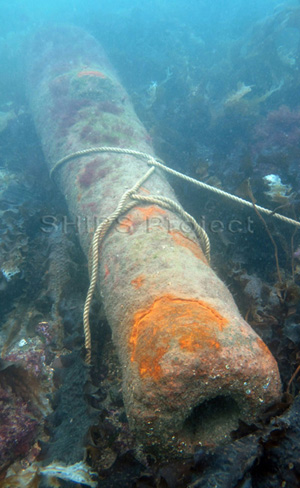
Coronation Gun 39 (SHIPS Project)
In 1971, Peter McBride, a naval diver with recent archaeological experience gained on similar sites, discovered a contemporary account which categorically stated the Coronation had foundered in 22 fathoms water off Rame Head, a depth beyond the range of salvage divers of the period. Realising this was a unique opportunity to discover a complete archaeological time capsule related to the Navy of the late 17th century, he decided to make a project of finding the great ship. Further research to pinpoint the location of the wreck was done at the Admiralty archives and at the National Archives in London where the ship’s logs can be found. The research was followed up by underwater searches using a small team of divers which included Simon Keeble, a merchant navy officer with navigational expertise and John Vaudin, an experienced diving instructor at Plymouth Polytechnic.
After searching the seabed for some months using divers it became apparent that finding the wreck without technical assistance was impractical. In the winter of 1973-4 a more formal project was put together and a number of divers with some expertise in wreck location and archaeology were invited to take part. Amongst these was Anthony Lonsdale, a scientist with professional expertise in scientific search and magnetometry. A few years earlier Lonsdale had successfully found the site of the Dutch East Indiaman Hollandia (1743) in deep water in the Isles of Scilly using a proton magnetometer. Lonsdale agreed to participate by supplying and maintaining the technical equipment including a magnetometer and over the next three years the techniques used by the team developed and improved. During 1974 & 1975 navigation and positioning of the anomalies detected by the magnetometer was achieved by sextant observation and sextant angle search chart. This was superseded in 1976 & 1977 by the permanent installation into the survey boat of the Mark 12 Decca Navigation Equipment, which greatly improved the accuracy and speed of the search.
On 10th August 1977 the magnetometer detected an iron object on the seabed. On investigation divers identified what they thought was a cannon buried up to it’s trunnions in the sea bed, pointing muzzle downwards with it’s cascabel missing. There was little else in the immediate area, but enthused by the discovery the team returned to the vicinity three days later on 13th August and covered the area with a detailed magnetometer search. Almost immediately a number of large anomalies were recorded 260m to the north east of the lone gun and when divers went to investigate the targets they were elated to find 6 large guns and a large anchor 18ft 6in long. Two days later the number of guns discovered had risen to 14 together with a second large anchor 17 ½ ft long. This was a climax to eight years work and thousands of hours work by a dedicated team of amateur researchers and divers. Five days after finding the site, with amazing good fortune, McBride identified a piece of pewter wedged between rocks and concreted to the seabed near a small gun in the centre of the site. Careful removal of the object revealed a pewter plate bearing the family crest belonging to Charles Skelton, the captain of the Coronation. A touch mark on the rear of the plate dated the plate to 1689, two years before the loss of the Coronation. Thus the site was finally identified as that of the 90 gun ship Coronation.
In 1978 the Coronation site became one of the first sites to be designated under the Protection of Wrecks Act of 1973 and a licence was issued for the subsequent survey and excavation of the site to McBride and the Coronation Nautical Archaeology Group. The site was surveyed and excavation gradually revealed a limited number of interesting artefacts.
In 1980 two divers of the Plymouth Sound Branch of the BSAC, Roger Dadds and Mike Glanfield, found a brass sword handle on the cannon site off Penlee Point. The handle was in the shape of a lion’s head which was a design used for a typical Royal Navy short sword or ‘hanger’, which would have been part of the armament used on the Coronation. Together with John Smart, Chairman of the Plymouth Sound Branch, the divers approached McBride and the handle was identified as being identical to one he had recovered from the Coronation site. The discovery sparked a new interest in the site; the Penlee site was finally identified to be part of the Coronation wreck and was renamed the Inshore site and the deeper site found by McBride became the Offshore site. The Penlee Exploration & Survey Team (PEST) was formed, a co-operative of archaeological teams from Plymouth Sound BSAC, Plymouth Polytechnic and the Coronation Nautical Archaeology Group. PEST put together a project to re-survey the Penlee site using the latest techniques available at that time. Smart was a professional civil engineer with archaeological experience so supervised a general survey whilst McBride controlled a specialist survey of all the guns using specialist tools and methods. The regular use of the same divers throughout the year provided operational continuity and familiarity with both the site and surveying techniques making the work go more smoothly. Being locally based the team could visit the site all year round and minimise the seasonal problems of thick kelp that grows on the site in the summer. The survey of the guns continued to the end of 1984 when the last guns under Penlee were recorded. During the PEST survey many new and previously unrecorded guns were found off Penlee and in the intermediate area between the Offshore and Inshore sites. By the end of 1984 no less than 83 guns had been recorded in detail.
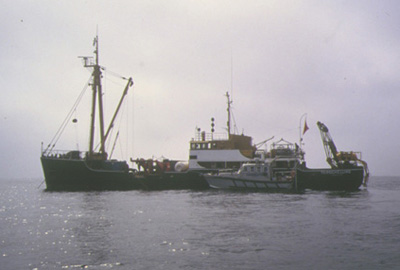
PMARIG working on the Coronation site in 1999 (SHIPS Project)
The Coronation sites have been dived, mapped and searched by many teams of divers over the 40 years since first found, but as the main sites are 800m apart the task has been rather difficult. The Inshore and Offshore sites were surveyed separately and attempts were made to join the maps together but it is only since the arrival of GPS that this has been achieved with any accuracy. Between 1996 and 1999 the PMARIG team led by Paul Dart re-mapped the Offshore site and Peter Holt used the Site Recorder software program to tie the numerous surveys together into a single site plan that covers the whole area. Recent geophysical surveys have identified a trail of wreck debris scattered on the seabed over a distance of more than 1200m.
For such a large ship surprisingly little of it has been found on the seabed. How much of the ship was salvaged at the time is not known, but contemporary letters state that material from the ship washed ashore including six masts and yards, several beams and mainsails, a quantity of canvas and a great deal of carved work. In the early years the site was regularly visited by divers who would often remove any objects they found, it has been said by one that they liked the tags the archaeological team would put on the objects as it made them easier to find! So far, 87 of the 94 guns carried by the ship have been found along with seven large anchors. Other objects that have been recovered include heavier metal items such as a bell, lead scupper pipes, bronze sheaves, round shot and sounding leads along with smaller items such as pewter bottle tops, a spur from a boot, musket balls and a ring. Only a small amount of rope was recovered and that found under a cannon, but no wood from the ship or any other organic material seems to have survived, which is typical of other naval wrecks of the period found in similar exposed conditions. Very few of the objects that have been found were an integral part of the ship and most have been larger items she carried like the guns and anchors. It would appear that the hull was either salvaged, or broke up and floated away after being subjected to centuries of south westerly winter gales.
One of the large 32 pdr guns (Gun 39) was recovered from the Inshore site in 1983 and was cleaned of concretion, recorded and drawn. The gun was put in the harbour at Fort Bovisand where it was used as a heavy weight for underwater lifting exercises for trainee divers. In 1996 Gun 39 was moved by the PMARIG team to the Breakwater Fort where it joined the recently scuttled pilot cutter Tavy as part of a training site for maritime archaeologists. In recent years the gun has moved again, back to the harbour at Fort Bovisand.
Recent survey work has been undertaken on the Coronation site with the support of 3H Consulting Ltd., CISMAS, Geosa Ltd., IxBlue, MAST, Plymouth University, ProMare, R2Sonic LLC, R.N. Hydrographic School, Sonardyne International Ltd. and Swathe Services Ltd.
Diving the Coronation
The Coronation is a designated protected wreck and permission is required before diving on the Offshore or Inshore site.
The wreck was designated under the UK Protection of Wrecks Act (1973) and diving on the site without permission is against the law. Access to the site is managed by the Coronation Wreck Project team, group requires a minimum of 14 days notice from divers who wish to dive either site and request a small donation from each diver towards maintaining the dive trail and continuing research on the site. There is a strict no-take policy in place on the site, which includes all marine life. For more information visit the Coronation Project web site www.coronationwreck.co.uk.
Divers visiting the Offshore site can follow a new diver trail installed on the seabed by the project team, divers are given a waterproof guide book and can follow a series of numbered markers around the 17 guns and three large anchors that form the offshore site. The guns and anchors lie in scattered groups in an area 45m by 20m in 18 metres depth on a rocky reef with a mix of deep and shallow gullies. The Inshore site is different as it is shallower at 5 to 10m depth, here the guns lie in deeper gullies topped with thick fronds of kelp so this area is best dived in the early part of the year when the kelp growth is at its lowest. Off Penlee Point 59 cannons and 3 anchors lie scattered along a debris trail more than 300m long.
Text: Peter McBride & Peter Holt
![]() If you have any more information about this ship then please contact us.
If you have any more information about this ship then please contact us.
Images
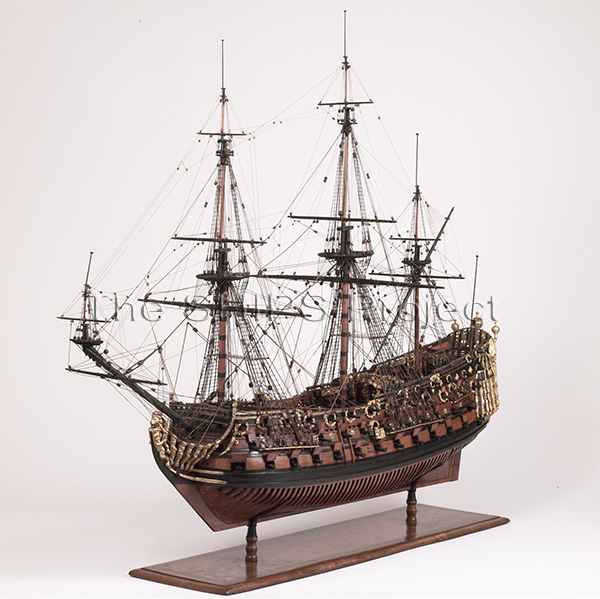
A model thought to be of the Coronation (Kreigstein Collection) |
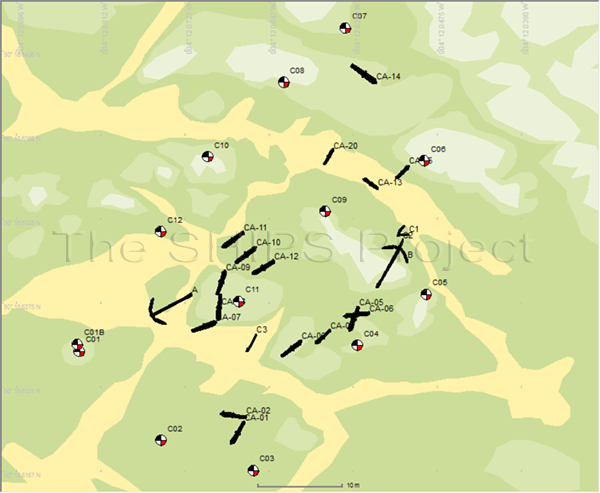
Plan of the Coronation Offshore site showing guns and anchors (3H Consulting Ltd) |
3D view of the Coronation Offshore site (3H Consulting Ltd) |
Multibeam sonar survey over the site in 2012 (R2Sonic/Swathe Services) |
Finds
Gun 39
82A01 Gunner's Ladle
09A09 Scupper
09A10 Nail
09A16 Nail
10A06 Lid
10A15 Spur
Links
3H Consulting Ltd., Case Studies: Coronation - www.3HConsulting.com

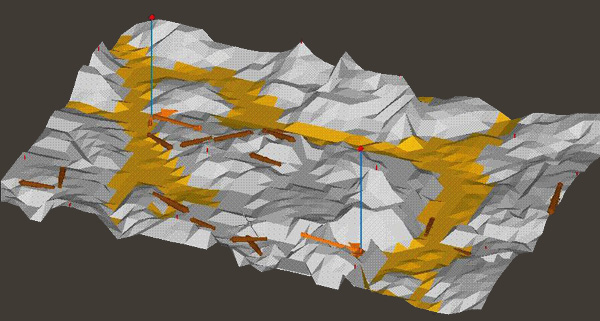
 sc500.jpg)